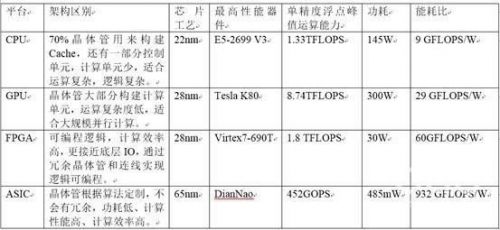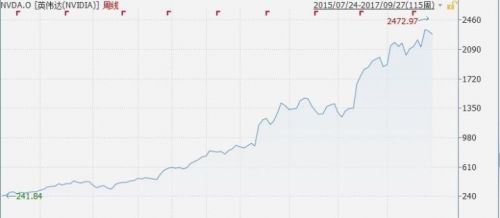The mainstream mobile phone market has become saturated, and the major players have robbed the next generation of terminals - self-driving cars. According to the experience of the Internet era in the past, the chip is always the most upstream of the industry chain, and is the industry leader. Core chips often determine the infrastructure of a computing age!
When the new computing era comes, it is often an excellent opportunity for emerging companies to overtake the curve. The GPUs and FPGAs currently used are not artificial smart custom chips. Naturally, there are limitations. Artificial intelligence chips are the same for IT giants and start-ups. The blue sea at the starting line.
At present, the new computing requirements of artificial intelligence represented by deep learning mainly use GPU, FPGA, AISC custom chip and other general-purpose chips suitable for parallel computing to achieve acceleration.

In this key area, Intel, NVIDIA and Qualcomm are the three chip giants. The competition they lead has contributed most of the drama to this chip war.
NVIDIA: Unlimited scenery
When it comes to artificial intelligence chips, Nvidia’s well-deserved global leader is all reflected in its stock price, which is ten times more than two years.

NVIDIA's GPGPU (Universal Computing GPU) does not need to be said in the depth learning field. Most of the deep learning is currently supported by NVIDIA's GPU during the training phase.
On the one hand, this is due to the fact that its GPU is more computationally intensive for deep learning than the CPU. On the other hand, NVIDIA's development ease of use for its GPU general-purpose computing is doing so well. Greatly reduced the difficulty for developers to get started.
Before the era of autonomous driving, Nvidia entered the list of suppliers of many OEMs through the Tegra series of processors. However, the early years of NVIDIA's Tegra were mainly responsible for in-vehicle entertainment.
This year's new Audi A8 with L3 autopilot uses NVIDIA's Tegra K1 chip to handle the car's surround vision. Tegra K1's single-precision floating-point computing capability reaches 350GFlops.
In fact, before the new Audi A8 debut, NVIDIA has continuously launched two generations of very powerful self-driving car computers. The most powerful version of Drive PX 2, Drive PX Autochauffeur, uses two SoCs called Tegra Parker. The precision floating point computing capability has reached 8TFlops.
However, behind the high performance of the Drive PX 2 is the price – the computing platform consumes up to 250W, and the huge heat generated requires water cooling; the price is as high as $15,000. This is not good news for autonomous cars that need to be mass-produced.
Of course, Nvidia sees this very clearly. After the Drive PX 2, a new generation of Volt-based GPU-based SoC Xavier was launched, with single-precision floating-point performance of 20 Tflops and power consumption of only 30 W. Xavier's powerful performance allows it to support the L4-L5's autopilot computing needs, while low power consumption and small size can be adapted to the needs of the vehicle.
Xavier's production time is early next year, and large-scale shipments will wait until the fourth quarter of next year.
Intel: not bad money
In the two years of deep learning, Intel has been lagging behind. Intel, which is not bad, bypassed the GPU and completed its acquisition of Altera, the world's second-largest FPGA company, in 2016 for $16.7 billion. Intel used the FPGA chip in Intel Go, an autopilot computing platform launched at the beginning of the year. Audi's new A8 autopilot also uses Altera's FPGA chips.
In March of this year, Intel acquired Israel's ADAS company Mobileye for a price of 15.3 billion US dollars.
On the one hand, Mobileye provides Intel with a channel to cut into the autopilot market. The former has a share of more than 70% in the global ADAS market. On the other hand, Mobileye's core product, the ADAS-specific chip EyeQ series, has enabled Intel to form a vehicle-oriented terminal. Compute chip solution - Intel's Atom + Mobileye's EyeQ + Altera FPGA. This $15.3 billion is actually a ticket that Intel bought for autonomous driving.
At present, the auto-driving vehicle terminal and the cloud have not realized real-time high-bandwidth transmission, so the computing power of the vehicle terminal is particularly important.
In addition, Intel has a strong presence in the server market, which means that in the cloud, it can deploy powerful computing power. Combined with low latency and efficient FPGAs, Intel can handle large amounts of concurrent real-time computing in the cloud. This model is especially suitable for people's vision of the smart city brain: every unmanned car's data is uploaded to a hub, which processes and understands the state of each car and commands them how to drive.
However, although this set of ideas is very advanced, standards and infrastructure construction will consume a lot of time and money, and it will still be difficult to achieve in the short term.
Qualcomm: The acquisition of NXP is still unknown
In 2014, Qualcomm launched the car chip Snapdragon 602A, which is mainly for the entertainment and audio computing needs of the car.
At the beginning of 2016, Qualcomm once again released the 820A based on the flagship SoC, specifically joining the hardware acceleration support for deep neural networks. Launching this in-vehicle SoC, Qualcomm is primarily targeting the ADAS market.
Although the Snapdragon SoC has an advantage over Intel and NVIDIA's computing platforms in terms of unit energy consumption, it is limited by its power consumption in peak performance output. In addition, the Snapdragon SoC is not a computing platform specially designed for ADAS, so it is not difficult to open the market.
For this issue, Qualcomm announced in October last year the acquisition of the world's largest automotive semiconductor manufacturer NXP. NXP's share of the global automotive semiconductor market in 2016 was as high as 14.6%. As the world's largest automotive semiconductor manufacturer, it has close ties with car manufacturers and suppliers. In a sense, Qualcomm’s acquisition of NXP this time is similar to Intel’s acquisition of Mobileye – buying an industry leader directly to open up new business.
However, the acquisition has not been finalized. This month, the EU anti-monopoly investigation agency once again suspended the effort on the acquisition, on the grounds that "the key details of the disclosure are still not enough." For Qualcomm, it is imperative that the acquisition of NXP needs to be completed soon.
The reason why IT giants such as NVIDIA, Microsoft, Qualcomm and Google have invested heavily in accelerating the research and development of artificial intelligence core chips are all intended to control the core chip architecture from the source and obtain the leading power in the era of artificial intelligence computing.
In the next 3-5 years, with the breakthrough of artificial intelligence custom chips, all industries will realize artificial intelligence. By then, the size and capacity of the intelligent market will be dozens of times higher than today's mobile Internet market.
Self-healing Hydrogel Screen Protector
The Screen Protector has a self-healing technology that can automatically eliminate small scratches on the Protective Film within 24 hours. Significantly reduce dust, oil stains and fingerprint smudges, anti-scratch.
The Screen Protection Film is very suitable for curved or flat screens. The Soft Hydrogel Film perfectly matches the contour of your device. Will not affect any functions of the phone.
The Ultra-Thin Protective Film with a thickness of only 0.14mm uses 100% touch screen adaptive screen touch screen technology, complete touch screen response, high-tech technology makes the screen touch to achieve zero delay, ultra-thin material brings you "realism".
The Protection Film has excellent clarity and incredible toughness, providing a high level of clarity and a glass-like surface, highlighting the sharpness of the most advanced smartphone display images and bright colors.
If you want to know more about Self Repair Screen Protector products, please click the product details to view the parameters, models, pictures, prices and other information about Self Repair Screen Protector.
Whether you are a group or an individual, we will try our best to provide you with accurate and comprehensive information about the Self Repair Screen Protector!
Self-healing Protective Film, Self-repairing Screen Protector,Self-healing Screen Protector, Self-Healing Hydrogel Film,Hydrogel Film Screen Protector
Shenzhen Jianjiantong Technology Co., Ltd. , https://www.jjthydrogelprotector.com